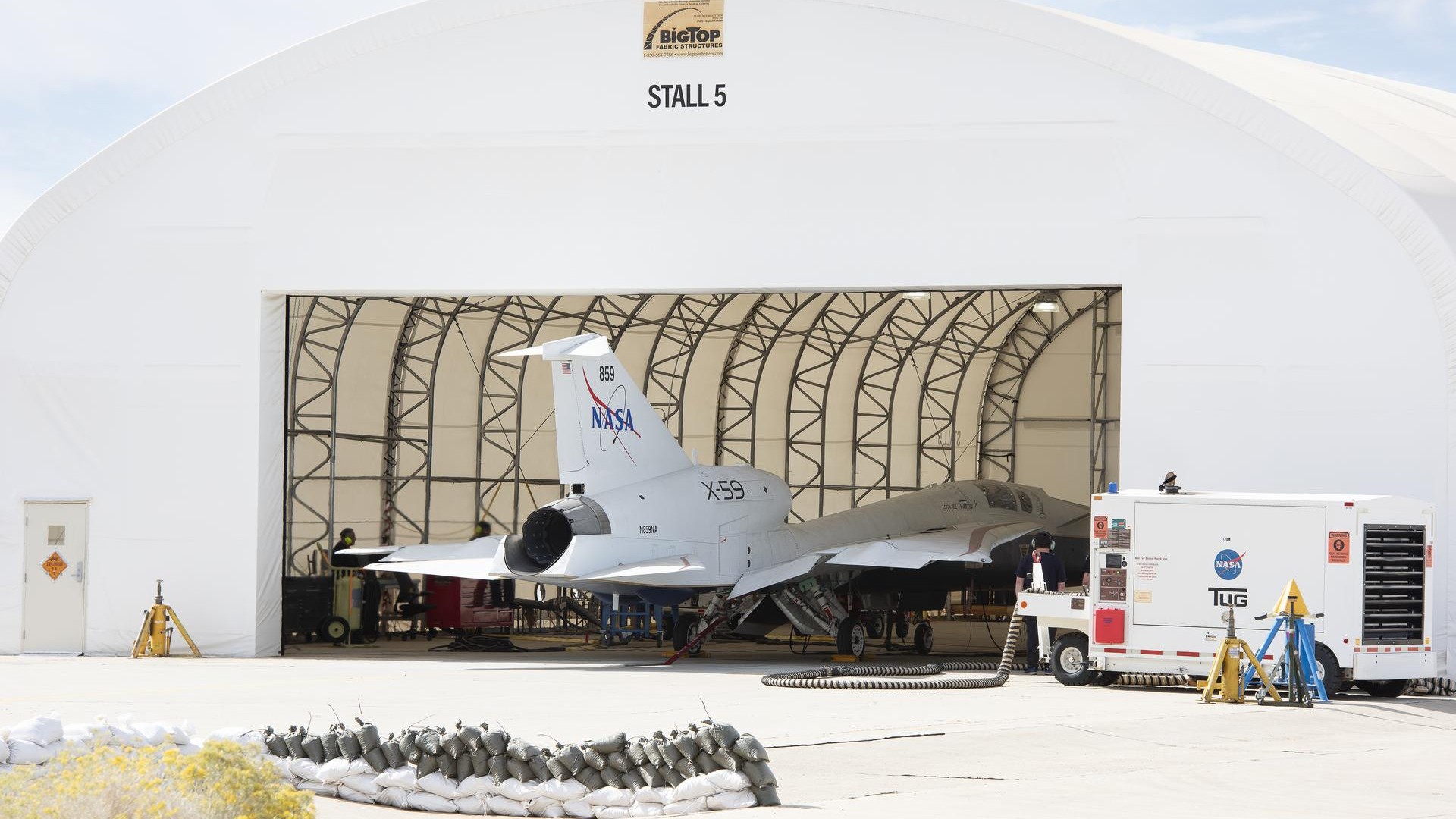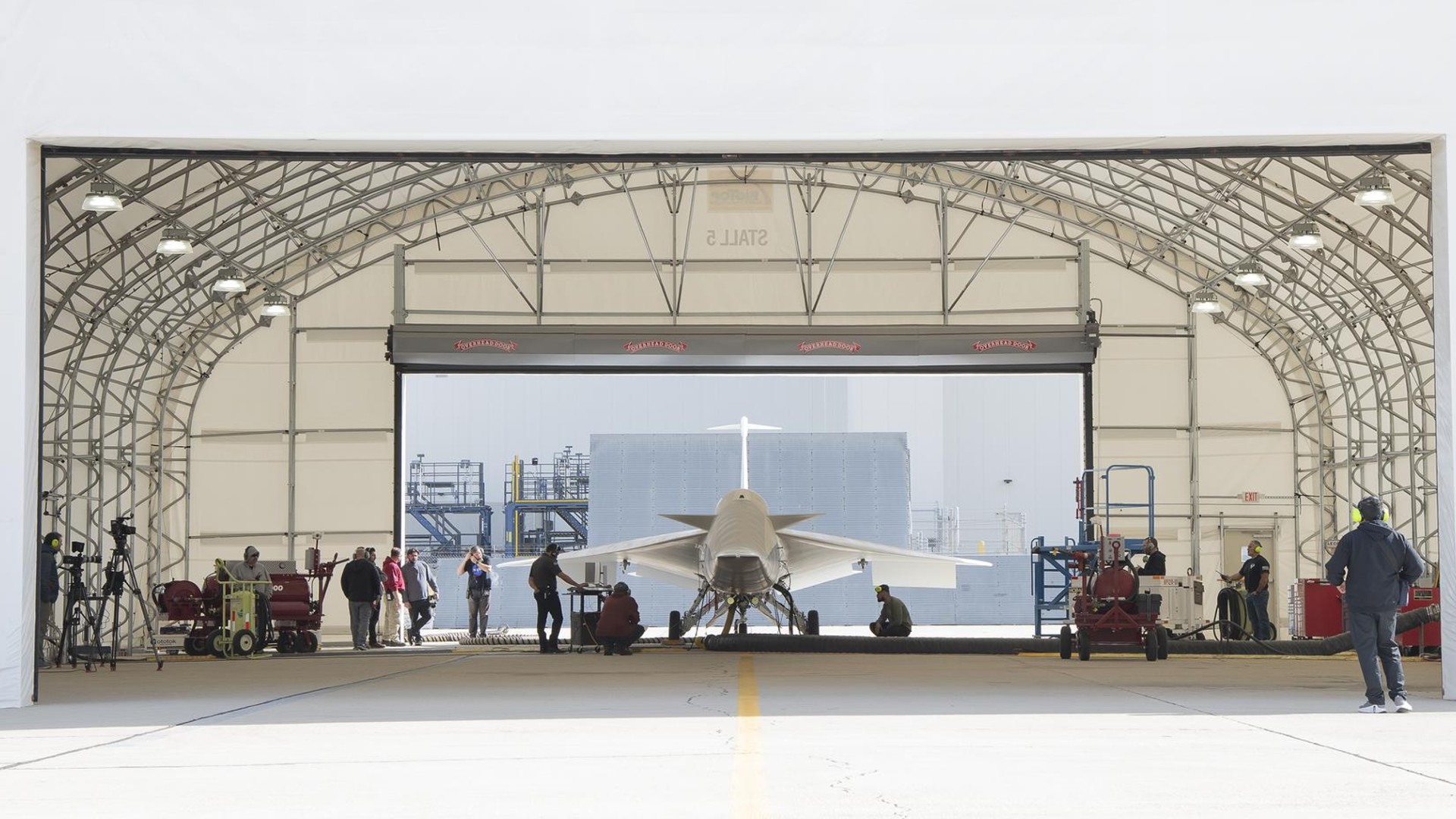NASA's X-59 'quiet' supersonic jet test fires engine for 1st time

NASA's revolutionary X-59 jet is steadily progressing towards its first flight test.
Starting on Oct. 30, engineers with NASA's X-59 Quesst program (Quiet SuperSonic Technology) have been conducting test runs of the jet's engines at the storied Lockheed Martin Skunk Works facility in Palmdale, California.
The tests are going in phases. During the preliminary tests, engineers ran the X-59's engines at low speeds without igniting it to check for any leaks and to make sure the aircraft's various systems work together when running on the jet's own power. The X-59 team then fueled the X-59 and tested the engine on low power. So far, engineers with the program say the jet is performing well.
"The first phase of the engine tests was really a warmup to make sure that everything looked good prior to running the engine," said Jay Brandon, chief engineer for the X-59, in a NASA statement.
"Then we moved to the actual first engine start. That took the engine out of the preservation mode that it had been in since installation on the aircraft. It was the first check to see that it was operating properly and that all the systems it impacted — hydraulics, electrical system, environmental control systems, etc. — seemed to be working."
The X-59 is designed to fly at a cruising speed of Mach 1.4 (or 1.4 times faster than the speed of sound) and an altitude of 55,000 feet (16.7 kilometers). The aircraft is powered by a modified F414-GE-100 jet engine made by General Electric; the F414 engine family is used widely throughout military aircraft, including in some variants of the Boeing F/A-18 Super Hornet flown by the U.S. Navy.
In fact, NASA has been using F/A-18s to simulate the sound of the X-59 and validate microphones and other acoustic sensors that will help in the jet's testing campaign.
The X-59 was designed to fly faster than the speed of sound without creating the thunderous sonic boom that typically accompanies breaking the sound barrier. Currently, supersonic flight above land within a certain distance of the U.S. is prohibited by the FAA. NASA hopes the X-59 can validate that supersonic flight is possible without creating deafening sonic booms; if aircraft can be designed to achieve this, domestic flight times could be reduced by half, aiding not only in commercial air travel but also disaster relief and medical transport, for instance.
Breaking space news, the latest updates on rocket launches, skywatching events and more!
To help reduce the volume of its sonic booms, the X-59 features a unique geometry including an elongated, beak-like nose section that takes up 38 feet (11.5 meters) of the aircraft's 99.7-foot (30-m) total length.
Rather than a loud, ground-shaking boom, NASA says the jet should make a soft "thump" when it breaks the sound barrier, similar in volume to the sound of a car door slamming outside, as heard from indoors.
Because of the elongated nose, however, pilots flying the X-59 have limited forward vision. In fact, the cockpit does not even feature a forward-facing window or canopy, but instead has a unique "eXternal Vision System," or XVS, consisting of a camera connected to a cockpit-mounted screen that offers pilots the ability to see what's in front of them via augmented reality technology.
"This groundbreaking technology is really a beacon guiding us towards a future where visibility barriers in aircraft design can be overcome with this inventive solution," NASA deputy administrator Pam Melroy said during the X-59 unveiling ceremony in January 2024.
"This isn't the end of the excitement but a small steppingstone to the beginning," said Paul Dees, deputy propulsion lead for the X-59 program, in NASA's statement.
"It's like the first note of a symphony, where years of teamwork behind the scenes are now being put to the test to prove our efforts have been effective, and the notes will continue to play a harmonious song to flight."
The next phase of testing will involve feeding data into the aircraft's computer systems for both normal and failure conditions to see how the vehicle responds. Following that, the X-59 will undergo taxi testing, where the jet will "drive" out of its hangar onto a runway to test how its control surfaces, brakes and engine perform while on the ground.
A date has not yet been set for the X-59's first flight. When it takes to the skies, the X-59 will fly over selected U.S. cities where researchers will collect data about the quieter "thumps" the Quesst makes as it flies, including how the public on the ground perceives and responds to the noise it makes.
The X-59 has undergone years of development and testing to get this far. NASA has been researching quiet supersonic technologies for decades.
NASA first got funding for the project in 2018 and, later that year, hired Lockheed Martin to build its quiet supersonic jet. The experimental aircraft got its name in 2019. NASA originally thought the X-59 could be completed by 2020, but the COVID-19 pandemic slowed the aircraft's production.
The jet was finally unveiled to the public in January 2024. In May, the jet passed its Flight Readiness Review, which validated the aircraft's testing plan for safety and offered recommendations to NASA and Lockheed Martin as they prepare for the X-59's first flight.

Brett is curious about emerging aerospace technologies, alternative launch concepts, military space developments and uncrewed aircraft systems. Brett's work has appeared on Scientific American, The War Zone, Popular Science, the History Channel, Science Discovery and more. Brett has English degrees from Clemson University and the University of North Carolina at Charlotte. In his free time, Brett enjoys skywatching throughout the dark skies of the Appalachian mountains.


